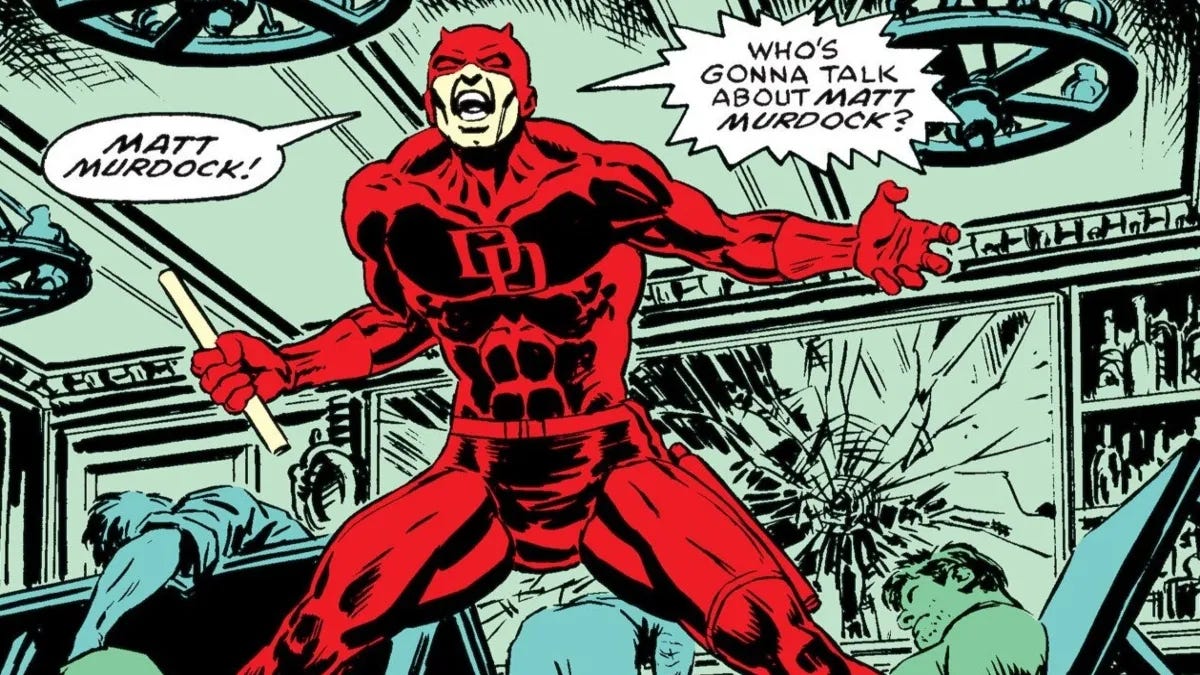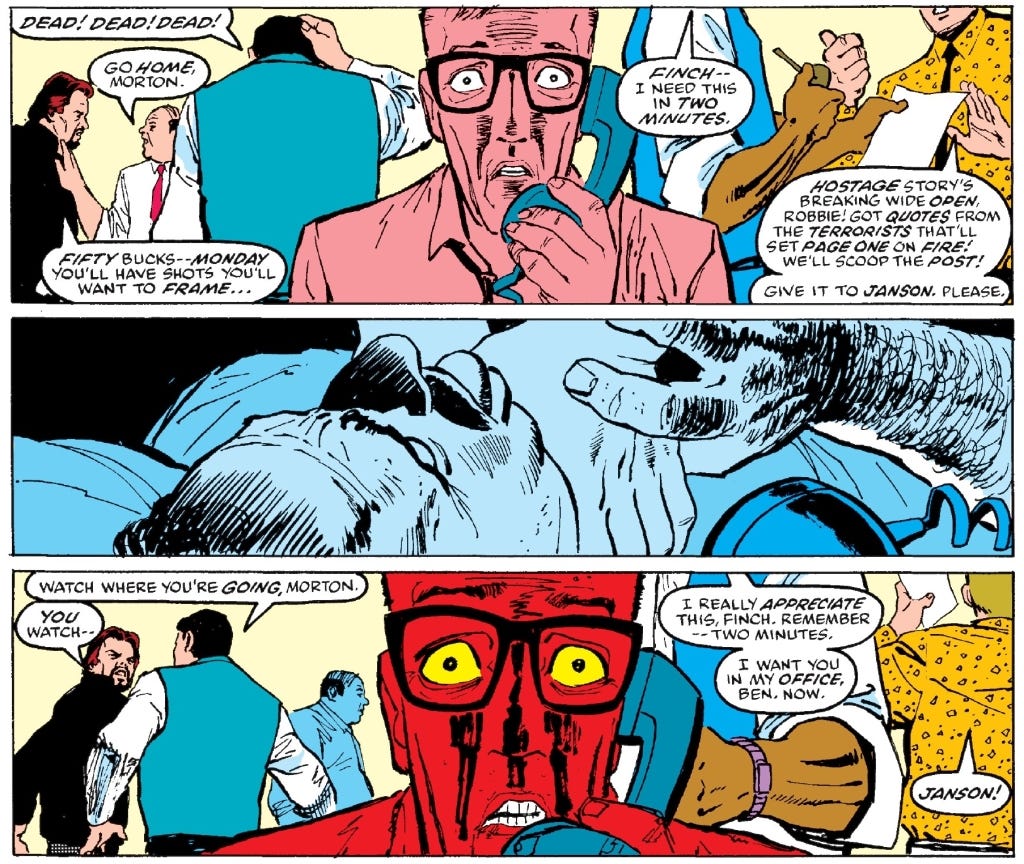Hey, everyone!
Time for something different. I’m all finished writing about the event comics that I missed. Now, it’s time to talk about some all-time classics. My friend Braden recently got Marvel Unlimited, so I’ve been helping him navigate all the best Marvel Comics he may not have read. This led me to reread Frank Miller’s groundbreaking Daredevil run, which led me to today’s topic: the iconic “Born Again” storyline.
For context, Frank Miller became the writer/artist of Daredevil in the early 1980s, revamping Matt Murdock into the character people know and love today. Alongside penciler/inker Klaus Janson, Miller’s run from Daredevil #168-191 took the titular hero from a swashbuckling Spider-Man wannabe to a gritty urban ninja.
Over the course of Miller’s run, Daredevil would take on crime bosses, deadly assassins, and lots of ninjas. Miller introduced major player into Daredevil’s world, including Elektra, Stick, and the Hand. Miller would also develop the villain Bullseye into a more serious threat. Miller’s greatest achievement might have been bringing the Kingpin, a Spider-Man villain, into Matt Murdock’s world and turning him into Daredevil’s archnemesis.
If Frank Miller had only done his initial time on Daredevil, I think that would have been more than enough. Miller had already redefined Matt Murdock for decades to come. But Miller was just getting warmed up. Three years later, Frank Miller returned and wrote the greatest Daredevil comic of all time, as a sort of victory lap. That’s iconic. And thus, “Born Again” came into existence.
This 1986 tale was written by Frank Miller and illustrated by Dave Mazzuchelli. It should be mentioned that there is a prelude story in Daredevil #226 which is co-written by Denny O’Neil and co-illustrated by Dennis Janke. But “Born Again” begins in earnest in Daredevil #227, continuing until #233, all by Miller and Mazzuchelli.
“Born Again” starts with Karen Page, Matt Murdock’s old assistant and love interest from the ‘60s. To say Karen has had a rough go of things would be an understatement. She’s become an adult film star hooked on heroin. As far as depictions of female characters go, it’s not great. Karen hits her lowest point when she sells Daredevil’s secret identity for her latest fix. This secret makes its way back to Wilson Fisk, the Kingpin.
With this, Fisk slowly begins to destroy The Man Without Fear’s life. Matt is disbarred from practicing law, his power is shut off, the IRS audits him, the bank doesn’t receive payments on his mortgage, and suddenly all the young adults in the room realize how relatable this is. Anyways, all the little things start to accumulate. Add all this to the fact that Matt’s ex, Heather Glenn, recently committed suicide, and the guy’s mental state starts deteriorating fast.
As Daredevil tries to figure out why all this is happening to him and begins losing his mind, his apartment is then blown up by the Kingpin. This really sets Matt off, as he goes to confront Fisk before being beaten nearly to death. Daredevil survives, albeit homeless and clinging to life. Matt is brought to his absolute rock bottom, but he manages, thanks to his resilience, faith, and some unexpected help, to rise back up.
I’d say more, but that would be spoiling a definitive tale for the Devil of Hell’s Kitchen. “Born Again” is the most popular Daredevil story for a reason. Daredevil goes through the wringer, more than almost any other hero has. The reader has to consider that, despite Daredevil’s extrasensory abilities, physically, he is just a regular human being.
Matt Murdock is both physically and personally vulnerable. Seeing Matt spiral and lose everything is compelling because, at his core, he’s just a man. Moreover, seeing Matt lose everything makes it that much more satisfying for when he gradually gets back up.
It’s this grit and determination which makes Daredevil such a compelling character. He survives on little more than willpower and faith. It is only once Matt loses everything that he can determine what is truly important in his life.
The reader gets to see Daredevil rebuild, using this clean slate to prioritize his friends, his loved ones, his community, and being a hero above all else. I think a lot of people would do well to step back and re-prioritize their lives in this way (although you don’t need to lose everything like Daredevil).
When it comes to the supporting characters in “Born Again,” Frank Miller also does a great job at constantly changing perspectives. The comic frequently jumps from one character’s perspective to another. There’s Karen Page, who feels guilt and shame over her part in Matt’s downfall and is desperately trying to get back to him.
There’s Ben Urich, the investigative reporter and Daredevil’s friend, who is attempting to expose the Kingpin’s crimes and find Matt. Ben’s fear and vulnerability without Matt to protect him from the Kingpin adds a lot of intensity to the story. We also see Foggy Nelson, Matt’s best friend and former law partner. Foggy has a budding romance with photojournalist Glori O’Breen, Matt’s ex (they only dated briefly, it’s fine), and they bond over a mutual concern for Murdock’s wellbeing.
Finally, there’s the Kingpin himself, who Miller continues to write as a complex, three-dimensional character. Over the course of the story, Fisk goes from toying with Daredevil to obsessing over destroying him. This gradually becomes a major detriment to the Kingpin’s criminal organization, ultimately leading to Fisk’s downfall. Even Captain America has a guest appearance at the end of “Born Again,” with a small albeit crucial part in the story. This is one of the best depictions of Steve Rogers, and it’s surprising that it happens in a Daredevil comic.
Ultimately, it’s amazing how naturally Miller can alternate through different perspectives, fleshing out the supporting cast and the villains, while keeping this a Daredevil-centric story. Everything revolves around Matt Murdock, and, throughout the comic, the reader can see that.
Additionally, we can see how important Matt is to everyone in his life, and how lost they are without him. When Daredevil makes his triumphant return, the reader can see how much brighter and optimistic things are for his supporting cast, and how much worse things get for the Kingpin.
Okay, now we can talk about the artwork. Spoiler: it’s incredible. David Mazzuchelli is a perfect match for Frank Miller. Miller’s words and Mazzuchelli’s artwork flow seamlessly together, matching each other’s styles and showing what the comic book medium can achieve.
Every panel, and every page for that matter, says so much through both words and imagery. Mazzuchelli is a master of storytelling. His work with movement, expressions, intensity, and suspense all shine through, and are perfect for “Born Again.”
Mazzuchelli also manages to capture key details, from the objects in a room to the small features of a character’s face. Big splash pages do an incredible job conveying important emotional and symbolic moments for the story. I’m no artist, but all I can say is, no notes.
Overall, “Born Again” is the definitive Daredevil comic. Every Daredevil story after this would take inspiration from this seminal comic in one form or another. Even other media, such as the Netflix series took major inspiration from “Born Again.” Heck, the upcoming MCU series is called Daredevil: Born Again.
It just hits all the right beats. The comic shows us that Matt Murdock is a grounded, tough-as-nails superhero who goes through so much physical and emotional torment, only to rise up stronger than ever before.
What I also like about “Born Again” is that it’s not necessarily about beating the villain. It’s more about not letting the villain beat you. We can see this as Matt rebuilds his life and his connections with those around him. The Kingpin, meanwhile, stews in hatred and obsession, ultimately defeating himself by refusing to let things go.
If I had one critique of “Born Again,” it would probably be the depiction of women, specifically Karen Page. Frank Miller has the unfortunate habit of making most of his female characters either sex workers or adult movie stars, leaving little room for much else.
Of course, there should be room for these occupations to be depicted in comics and other media. There’s nothing wrong with including a character who is a sex worker or porn star. It’s just a bit excessive when Miller makes that almost every female character, especially in Karen’s case.
More importantly, Karen sells Matt out for some heroin. It’s necessary to get the plot started, but it’s still damaging to Karen as a character. Karen in “Born Again” is a big departure from her previous characterization, and I have to say I much prefer the Karen Page from the Netflix series. On the upside, at least we get to see Karen’s point of view, highlighting her guilt for betraying Matt and her journey to find him and seek forgiveness. Still, hopefully this part doesn’t get adapted for other media.
In the years after its publication, “Born Again” would go on make a major impact, not only on Daredevil, but comic books as a medium, and Frank Miller’s career. After “Born Again,” Miller would be approached by DC to write Batman. Moreover, Miller would write two of the most iconic Batman stories of all time.
Miller wrote and illustrated The Dark Knight Returns, before collaborating with David Mazzuchelli once again on Batman: Year One. And if you haven’t heard of those legendary comics, I guess I’ll save them for a future newsletter.
But all of that was made possible by Frank Miller’s work on Daredevil. So, if anyone tells you that Daredevil is just a Batman rip-off, just remember, Frank Miller wrote definitive stories for both characters. And he worked on Daredevil first!
Next time: Supergirl: Woman of Tomorrow!











